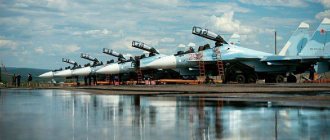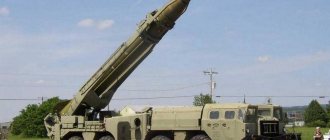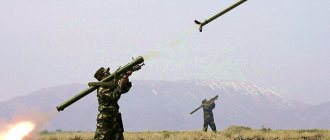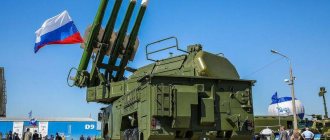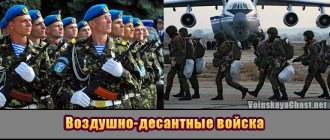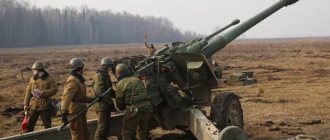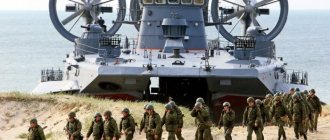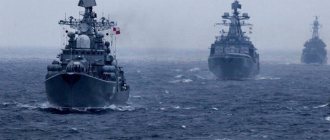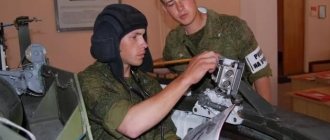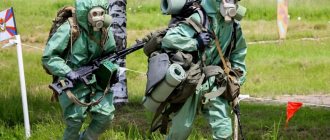The air defense troops of the Russian Ground Forces were created to cover troops and objects from the actions of enemy air attacks in any situation: during combat operations, on the march or in the field.
The air defense forces include military command and control bodies, air defense command posts, anti-aircraft missile, rocket-artillery and radio-technical formations, military units and subunits.
History of air defense
The date of formation is the date of creation of the Petrograd air defense system, namely December 8 (November 25), 1914.
- 1930 - the first Air Defense Directorate (since 1940 - the Main Directorate).
- 1941 – Air Defense Forces were formed.
- 1948 - withdrawal of air defense troops from the subordination of the artillery commander and transformed into a separate branch of the armed forces.
- 1954 – the High Command of the Air Defense Forces was formed.
- 1978 - the transportable S-300PT air defense system entered service (it replaced the old analogs of the 3RS S-25, S-75 and S-125).
- Mid-80s - the S-300PT air defense system underwent numerous modernizations, as a result, receiving the designation S-300PT-1.
- 1982 - a new version of the S-300PT air defense system entered service - the S-300PS (self-propelled complex) with a record deployment time of five minutes, making it highly vulnerable to enemy aircraft.
- 1987 was not the best year in the history of the air defense forces. On May 28, Matthias Rust's plane landed on Red Square in Moscow (at 18.55). This clearly demonstrated the vulnerability of the legal basis for the actions of the duty forces of the Air Defense Forces. That is, it became obvious that the tasks assigned to the Air Defense Forces were not completed. Then many military men were removed from their positions: three Marshals of the Soviet Union were injured (among them Sokolov S.L., Koldunov A.I.), as well as about 300 generals and officers. The army has not seen such a personnel pogrom since 1937.
- 1991 – The Air Defense Forces, due to the collapse of the USSR, were transformed into the Russian Air Defense Forces.
- 1993 - an improved version of the S-300PS, the S-300 PM, entered service.
- 1997 – 3RS S-300MP2 “Favorit” entered service.
- Until 2000, many types of armed forces were reorganized, the number of which was reduced from 5 to 3. All this was due to the acceleration of the physical aging of military equipment and weapons. Within the framework of the organization, two types of armed forces were united - the Air Defense Forces and the Air Force.
- In 1998, on the base of the Air Force and Air Defense Forces, the Directorate of the General Staff of the Air Force and the Commander-in-Chief of the Air Force was formed, and the Air Force and Air Defense troops were united into a new type - the Air Force. At that time, the Air Defense Forces included: an operational-strategic formation, two operational, four operational-tactical formations, five air defense corps, ten air defense divisions, 25 fighter regiments, 63 units of anti-aircraft missile forces, 35 units of radio-technical troops, 5 units of radio-electronic struggle, 6 units and formations of reconnaissance. It was armed with 20 aircraft of the A-50 radar patrol and guidance complex, more than 700 air defense fighters, 420 radio engineering units with radar stations of various modifications and more than 200 anti-aircraft missile divisions. As a result of all the activities, a new organizational structure of the Air Force was created. Instead of air armies, air defense and air force armies were formed, operationally subordinate to the commanders of the military districts.
- 2005 – 2006 - part of the military air defense formations and units equipped with ammunition complexes and S-300V anti-aircraft missile systems was transferred to the Air Force.
- In 2007, the S-400 Triumph anti-aircraft missile system entered service with the Air Force, the main task of which is to defeat all modern and promising air and space attack weapons.
- 2008 - at this time the Air Force included: an operational-strategic formation (KSpN), 5 operational-tactical and 8 operational formations (air defense corps), 165 units and 15 formations. This year began the transition to the formation of a new image of the Armed Forces of the Russian Federation (including the Air Force). As a result, the Air Force switched to a different organizational structure. Air Defense and Air Force commands were formed, subordinate to the newly created operational-strategic commands: Eastern (headquarters in the city of Khabarovsk), Central (Ekaterinburg), Southern (Rostov-on-Don) and Western (St. Petersburg).
- 2009-2010 – transition to a two-level air force control system (the system was called brigade-battalion). As a result, the total number of Air Force formations was reduced from 8 to 6, all air defense formations (4 corps and 7 divisions) were reorganized into 11 aerospace defense brigades.
- In 2011, three air defense brigades of the operational-strategic command of the aerospace defense became part of a new type of troops - the Aerospace Defense Forces.
- 2015 The Aerospace Defense Forces were merged with the Air Force and a new branch was formed - the Aerospace Forces. In their composition, a new type of troops was organizationally identified - the Air Defense and Missile Defense Troops (air defense and missile defense troops). The air defense and missile defense troops are represented by a missile defense and air defense unit.
As part of the subsequent development and improvement of the air defense system, the creation of a new generation of 3RS S-500 is currently underway, which implies the use of the principle of separately solving the problems of destroying aerodynamic and ballistic targets.
The main task of the complex is to combat the combat equipment of medium-range ballistic missiles, and, if necessary, intercontinental ballistic missiles in the final section of the trajectory, and, to some extent, in the middle section.
"Antey-2500" S-300
According to experts, this is the only mobile air defense missile system in the world. It is capable of intercepting even a ballistic missile designed for medium and short range. In addition, even the Staelth stealth aircraft can become the target of Antey. The system destroys an object using 2 or 4 9M83 anti-aircraft guided missiles. 3RS is produced by the Almaz-Antey concern for air defense units of Egypt, Venezuela and Russia. Until 2015, they were produced for export to Iran.
"Antey-2500" S-300
Main goals
Air Defense Forces (Air Defense Forces) are a branch of the Ground Forces, designed to cover troops and objects from the actions of enemy air attacks when combined arms formations and formations conduct operations (combat operations), perform regroupings (march) and are stationed on the spot. They are responsible for the following main tasks:
- carrying out combat duty in air defense;
- conducting reconnaissance of enemy air and alerting covered troops;
- destruction of enemy air attack weapons in flight;
- participation in the conduct of missile defense in theaters of military operations.
Organizationally, the Air Defense Forces of the Army consist of military command and control bodies, air defense command posts, anti-aircraft missile (missile and artillery) and radio technical formations, military units and subunits. They are capable of destroying enemy air attack weapons in the entire range of altitudes (extremely low - up to 200 m, low - from 200 to 1000 m, medium - from 1000 to 4000 m, high - from 4000 to 12000 m and in the stratosphere - more than 12000 m) and flight speeds.
Formations, military units and air defense units of the Army are equipped with anti-aircraft missiles, anti-aircraft artillery, anti-aircraft gun-missile systems (systems) and man-portable anti-aircraft missile systems that vary in reach, channel and methods of missile guidance. Depending on the range of destruction of air targets, they are divided into short-range systems - up to 10 km, short-range - up to 30 km, medium-range - up to 100 km and long-range - more than 100 km.
Further development of the air defense forces of the ground forces is carried out by increasing mobility, survivability, secrecy of operation, degree of automation, fire performance, expanding the parameters of the affected area, reducing reaction time and weight-dimensional characteristics of anti-aircraft missile (missile and artillery) systems.
Educational establishments
The training of specialists for military air defense formations is carried out by the Military Academy of the East Kazakhstan region named after Marshal of the Soviet Union G. K. Zhukov in Tver, the Yaroslavl Higher Military School of Air Defense, as well as the Center for Training Specialists of Radio Engineering Troops in Vladimir and the Training Center of Anti-Aircraft Missile Forces in Gatchina (Leningrad Region).
Officers serving in the departments of associations and formations are involved in the training. In addition, there is a practice of interaction with training centers of industrial enterprises.
Thus, in 2016, the educational, training and JSC NPO Lianozovo Electromechanical Plant (Moscow) trained more than 200 military personnel of the anti-aircraft missile and radio engineering troops.
The main prospects for the modern development of air defense troops of the Ground Forces
The main areas towards which the development of modern air defense forces is directed are:
- Change and reorganization of all structures related in one way or another to air defense. The main task of the reorganization is to maximize the use of all resources and combat power of missile weapons that are now entering service. Another task of paramount importance is to establish maximum interaction between air defense troops and other groups of troops of the Russian Army;
- Development of new generation weapons and military equipment that will be able to fight not only with existing air attack weapons, but also with the latest developments in the field of hypersonic technologies;
- Change and improvement of the personnel training system. Particular attention should be paid to changing the training program, because it has not changed for many years, although new air defense systems have long been adopted for service.
The priority continues to be the planned development of the latest air defense models, the modernization of older models and the complete replacement of outdated air defense systems.
In general, the modern air defense system is developing in accordance with the words of the famous Marshal Zhukov, who said that only a powerful military air defense system is capable of repelling sudden enemy attacks, thereby giving the Armed Forces the opportunity to engage in a full-scale battle.
Radar P-18
With the help of this modernized station, aircraft are detected. Their coordinates are determined and then given as a target. According to experts, at the moment the operational resource of such Russian air defense systems has exhausted itself. To extend and improve the performance characteristics, an installation complex with a service life of at least 20 years and wear and tear of no more than 12 years is used for modernization. Thus, they are replacing the outdated P-18 element base with a modern one, and the tube transmitting device is being replaced with a solid-state one. In addition, radars are equipped with systems with digital processes that process the signal and suppress active noise interference. As a result of numerous works, the equipment in this radar is not so voluminous. In addition, the system has become more reliable, with improved performance and accuracy characteristics and more protected from interference.
Modern air defense systems and air defense systems in the Russian air defense forces
One of the main air defense systems in service with air defense forces is the S-300V system. This system is capable of hitting air targets at a distance of up to 100 km. Already in 2014, the S-300V air defense system began to be gradually replaced by a new system, which was called the S-300V4. The new system is improved in all respects; it is an improved modification of the S-300B, differing from it in its increased range, more reliable design, which has improved protection against radio interference. The new system is capable of more effectively combating all types of air targets that appear within its range.
The next most popular system is the Buk air defense system. Since 2008, a modification of the complex called Buk-M2 has been entering service with the air defense forces. This air defense system can simultaneously hit up to 24 targets, and the range of destruction of targets reaches 200 km. Since 2016, the Buk-M3 complex has been put into service, which is a model made on the basis of the Buk-M2 and seriously modified.
Another popular air defense system is the TOR complex. In 2011, a new modification of the air defense system began to enter service, called “TOR-M2U”. This modification has the following differences from the base model:
- She can conduct reconnaissance on the move;
- Fire at 4 air targets at once, thereby ensuring an all-angle defeat.
The newest modification is called “Thor-2”. Unlike previous models of the TOP family, this modification has a doubled ammo capacity and is capable of firing on the move, ensuring complete safety of troops on the march.
In addition, Russian air defense systems also have man-portable anti-aircraft missile systems. The ease of training and use of this type of weapon makes it a serious problem for enemy air forces. Since 2014, the air defense units of the Ground Forces began to receive new Verba MANPADS. Their use is justified when it is necessary to operate in conditions of powerful optical interference, which complicate the operation of powerful automatic air defense systems.
Currently, the share of modern air defense systems in the air defense forces is about 40 percent. The latest Russian air defense systems have no analogues in the world, and are capable of providing complete protection against sudden air attacks.
Radar P-15 and P-19
With the help of these Russian air defense systems, low-flying targets are identified. They have been in service since 1955. These radars equip artillery, radio and anti-aircraft formations, command and control posts of air defense units. The station is transported using one vehicle with a trailer. The radars deploy within ten minutes. The station operates in coherent-pulse and amplitude modes.
Radar P-15
Using the P-19 radar, reconnaissance is carried out at medium and low altitudes. The information received is then transmitted to the command post. This radar is a mobile two-coordinate radar station, for transportation of which two vehicles are used. The first is used for transporting indicator and transceiver equipment, means for protection against interference, while the second is used for the antenna-rotating device and units that provide power to the system.
Emblem
The emblem of the air defense forces includes an image of three arrows and an anti-aircraft gun barrel on a black field. The crossed arrows in the field symbolize the determination and steadfast unity of the Ground Forces, Airborne Forces and Coastal Forces of the Navy.
The anti-aircraft gun signifies continuity with the military air defense units of the Armed Forces of the Russian Federation. The black field is the traditional color of the air defense troops. The oak wreath decorating the emblem signifies courage, valor, strength and steadfastness of the warriors.
Radar P-40A
It is a radar rangefinder, which is listed in the technical documentation as “Armor” 1RL128. This air defense system is aimed at performing the following tasks:
- identification of an air target;
- antennas are brought to the target automatically and calculate its altitude;
- determines azimuth and slant range;
- the built-in “friend or foe” program determines the state ownership of the object.
Radar P-40A
The complex is equipped with radio engineering units and air defense formations, anti-aircraft artillery and missile units. The “Armor” design is antenna-feeder. The location of the equipment, components and ground-based radar interrogator is the 426U self-propelled tracked chassis. There is also space for two gas turbine units that provide power to the system.
Air Defense Forces Day
December 26 is the Day of the Air Defense Forces of the Russian Ground Forces.
The air defense of the Ground Forces, which is also called military, and the air defense of the Aerospace Forces, also known as object air defense, should not be confused. These are completely different types of Armed Forces, performing different tasks. Even the dates of their professional holidays are completely different.
The choice of the date of this professional holiday is due to the fact that on December 26, 1915, or according to the old style of the 13th, the Chief of Staff of the Supreme Commander-in-Chief, General Mikhail Alekseev, issued an order to form the first artillery batteries to fire at enemy aircraft. Then, at the height of the First World War, they were intended against the combat aircraft of Germany and Austria-Hungary. These first air defense units included four light guns.
Air defense of the USSR
The first years after the war were characterized by growing tensions in relations between the USSR and the USA, and subsequently by threats from NATO countries using atomic weapons.
For defense, districts, special corps and air defense regions of the country are formed. Since 1951, the creation of a single radar space for the country began, which was controlled by new radars and systems of radio engineering troops created in the air defense structure.
Since 1955, a special army formation consisting of 4 corps, which were armed with the new S-25 air defense systems, was formed and took up combat duty for the defense of the capital. Soon the anti-aircraft artillery was transformed into anti-aircraft missile air defense forces, which became an independent separate military branch.
The armed conflicts of the 50s, in which military personnel of the USSR Armed Forces took an unspoken but direct part, make it possible to improve not only the types of weapons, but also the tactics of use, the organization of interaction and support of air defense units during combat operations.
Soviet anti-aircraft self-propelled gun ZSU-23-4 "Shilka"
With the development of rocket and space weapons in the 60s, tests were carried out at the test site of the possibility of intercepting the warhead of a ballistic missile using a high-explosive fragmentation anti-missile system.
The result was positive, which made it possible to develop and gradually put on combat duty segments of the A-35 missile defense system to cover the Moscow region.
Since 1967, the air defense system has included troops that specialize in defense against missiles in air and space. They develop and test spacecraft to destroy missile elements in low-Earth orbits.
In the process of modernization and development of new types of air defense systems, means of detecting an attacking enemy and warning of a possible missile attack, the most important objects of our country were covered by air defense systems of various ranges.
The destructive events of the 80s, which led to the collapse of the socialist camp and the Warsaw Pact Organization, affected the organization and condition of the army: transformations of the Armed Forces, a significant reduction in the external contingent and many weapons, and the release of military products had a negative impact, including on the air defense troops.
Interesting Facts
At the end of the 19th century, the first training shooting at balloons took place in Russia, and in 1908-1909, experimental shooting at moving targets was carried out: balloons and balloons moved with the help of horses. The tests involved 76-mm guns (“three-inch”). The shooting showed both the possibility of hitting aerial targets with gunfire and the need to refine field guns—to create specialized anti-aircraft guns.
The crews of the S-75 Dvina air defense system showed high combat effectiveness during the Vietnam War (1965 - 1973). From their fire alone, American troops lost more than 1,300 planes and helicopters.
"Sky-SV"
To identify an enemy target in the airspace, a two-dimensional radar operating in standby mode is used. The system is represented by a mobile coherent-pulse station. Transported by 4 vehicles, namely 3 cars and 1 trailer. The first vehicle carries transceiver, indicator equipment and means that automatically capture and transmit information. The second vehicle is designed to transport an antenna-rotating device, and the third is for a diesel power plant. The trailer has space for an HP3 antenna-rotator device. The radar system is supplied with interface cables and 2 remote indicators with all-round visibility.
Notes
- ↑
- ↑
- ↑ Deputy Commander of the Aerospace Defense Forces for Air Defense, Major General Kirill Makarov.
.
Radio station "Russian News Service".
Online publication "RIA Novosti" . MIA "Russia Today" (04/04/2015). - . Armed Forces of the Russian Federation
. Internet portal of the Russian Ministry of Defense. - . Structure of the Ground Forces of the Armed Forces of the Russian Federation
. Internet portal of the Russian Ministry of Defense. - ↑ Andrey Demin, Major General, Commander of the Air Defense-Missile Defense Command of the Aerospace Defense Forces.
.
Article published in newspaper issue No. 30 (548)
. Newspaper "Military-Industrial Courier" (August 20, 2014). - ↑ . Website “Vestnik Air Defense”. Author's project of Said Aminov
(02.03.2008). - ↑ Office of the Press Service and Information of the Ministry of Defense of the Russian Federation.
.
News
. Internet portal of the Russian Ministry of Defense (04/14/2013). - Dmitry Sergeev.
. Internet portal of the television and radio company “Zvezda” (3.08.2015). - . News
. Internet portal of the Russian Ministry of Defense (04/08/2012). - Directorate of Press Service and Information of the Ministry of Defense of the Russian Federation.
.
News
. Internet portal of the Russian Ministry of Defense (04/12/2014). - Order of the USSR Minister of Defense of August 20, 1954
- (unavailable link). Retrieved November 5, 2022.
- . Defending Russia
(Oct 23, 2014). Retrieved October 9, 2022. - ↑ (09/21/2016). Retrieved May 3, 2022.
